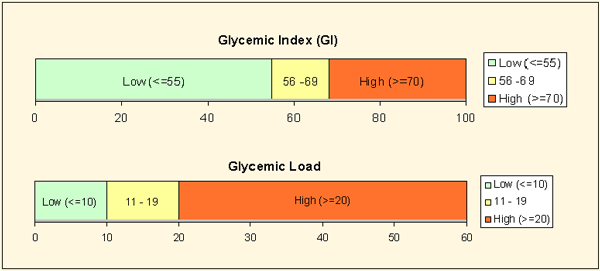Difference Between Glycaemic Index and Glycaemic Load
 Glycaemic Index vs Glycaemic Load
Glycaemic Index vs Glycaemic Load
The terms glycaemic index and glycaemic load refer to quantification of carbohydrates. Carbohydrates are classified as simple or complex based on the number of simple sugars in a molecule of carbohydrate. Complex carbohydrates are composed of long chains of one or two simple sugars like fructose or sucrose. Starchy foods are known as complex carbohydrates because starch is composed of long chains of the simple sugar, glucose. When carbohydrates are digested, these sugars enter the blood stream. Based on the number of simple sugars the food has, the rate of carbohydrate break down and its effect on the blood sugar level are determined. This is how the glycaemic index and glycaemic load are used to help diabetics make dietary adjustments.
Difference in meanings:
The glycaemic index ranks how quickly the sugar enters the blood stream after the consumption of the carbohydrate. Once the blood sugar rises in the blood, your brain signals your body to secrete more amount of the hormone insulin from your pancreas. Insulin helps to decrease the levels of sugar in your blood by converting excess sugar into fat. This subtle balance is important because excess insulin secretion may result in fatigue, weight gain and type 2 diabetes. Thus, glycaemic index helps understand how rapid the blood sugar levels rise after eating a food. In contrast, glycaemic load helps understand how much sugar a food item has and how quickly it will be utilized by the body, making it a more accurate indicator of the blood sugar rise.
Difference in usage:
Food is categorized from low to high on a scale 0 to 100, depending on its effect on blood sugar levels. Foods are classified based on their Glycaemic index as having a low GI (up to 55) , medium (56 to 70) and high (above 70) for utility. Foods that have the lowest glycaemic index have got the lowest rate of glucose entry into the blood stream and therefore have the lowest insulin response. Dietary fibers, proteins and fat slow down the entry of glucose into the blood stream. Most vegetables and whole grains are full of fiber and thus have lower glycaemic index. Processed foods e.g. white flour contains very less fiber and thus has a higher glycaemic index. The only drawback of glycaemic index is that it does not take into account how much sugar a particular food contains; it just shows how quickly the sugar is absorbed. For example the sugar in carrots is absorbed quickly and thus carrots are said to have a high glycaemic index. This is incomplete information as the amount of fiber in carrots is so high that the quantity of sugar being absorbed is very low; at this point identifying the glycaemic load of a particular food is useful.
Glycaemic load takes into account not only how quickly a certain food is converted into sugar in the body, but also how much sugar the particular food contains. Glycaemic load accounts for how much carbohydrate is present in the food and how much each gram of carbohydrate in the food raises blood glucose levels. Glycaemic load utilizes the glycaemic index. Glycaemic load of food is calculated as carbohydrate content measured in grams multiplied by food’s glycaemic index and divided by 100. Glycaemic load appears to be beneficial in dietary programs especially targeting metabolic syndrome, insulin resistance and weight loss.
Studies have showed that women whose diets have the highest glycaemic index were more likely to develop diabetes compared to those whose diets had lowest glycaemic index.
Summary:
Glycaemic index tells about how rapidly the blood sugar level will rise after consumption of a food product. Glycaemic load uses the information of glycaemic index as well the amount of sugar the food contains to determine the rise in blood sugar level after eating a food. Thus, glycaemic load helps weight watchers much more than glycaemic index.
- Difference between near sightedness and far sightedness - January 21, 2015
- Difference between Diverticulosis and Diverticulitis - January 20, 2015
- Difference between Prilosec and Nexium - January 19, 2015
Search DifferenceBetween.net :
1 Comment
Leave a Response
References :
[0]http://www.mendosa.com/GL_and_GI-Chart.gif

Could you give some more examples, like the carrot one was easy to understand. Say Oats, beetroot, dals (split beans)
Also how do vegetarians manage to keep glycemic load low.